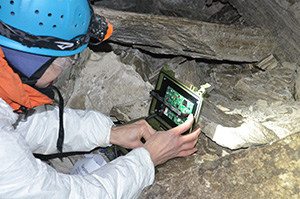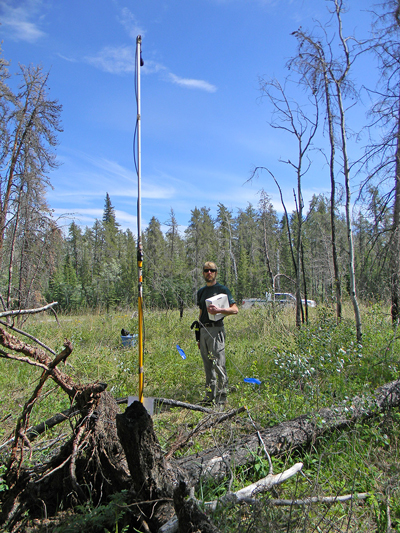
Little Brown Bats in karst cave, Wood Buffalo National Park
Photo: Parks Canada / Sharon Irwin
Bats
Wood Buffalo National Park
Bats are fascinating and beneficial to humans, and are important to the maintenance of healthy ecosystems. As voracious consumers of insects - including agricultural and forestry pests – bats help keep insect populations under control. Parks Canada sites protect habitat for bats, playing an important role in their protection and conservation within North America.

Photo : Parks Canada
Six species of bats live in Wood Buffalo National Park: Little Brown Myotis, Northern Myotis, Big Brown Bat, Silver-haired Bat, Hoary Bat and Eastern Red Bat. The first three species listed – known as cave bats – hibernate in the park over the winter, surviving the frigid temperatures in karst caves underground. Two of those species – Little Brown Myotis and Northern Myotis – are classified as endangered under the federal Species at Risk Act. The remaining bat species found in the park (Silver-haired Bat, Hoary Bat and Eastern Red Bat) – known as tree bats - migrate south for winter.
Like all living creatures in the park, bats benefit from the protection of nocturnal conditions within their habitat under Wood Buffalo National Park’s designation as a Dark Sky Preserve.
Why Are Bats At Risk?
North American bat populations are at risk from habitat loss and fragmentation, wind energy development, and climate change. In some parts of Canada (and elsewhere in North America), bat populations have been severely impacted by a bat disease known as White-Nose Syndrome. While there is no evidence yet of this bat disease in Wood Buffalo National Park or other known bat habitats in northern Canada, there is concern that this devastating bat disease will spread across Canada over time. In the meantime, Parks Canada sites with healthy bat populations – such as Wood Buffalo National Park – are increasingly important for bat conservation within North America.
North American Bat Monitoring Program

Photo : Parks Canada
The North American Bat Monitoring Program (NABat) started in 2014 as a coordinated continent-wide multiagency program aimed at gathering information on bat populations and their health across North America. The program is needed not only to provide information about the impacts of White-Nose Syndrome, but also to inform management and policymakers about other potential threats that may harm bat populations across the continent over time. Parks Canada is a participant in this program and undertakes bat monitoring activities in many of its parks and sites.
Bat Monitoring in Wood Buffalo National Park
In Wood Buffalo National Park, acoustic bat monitoring surveys are conducted annually every June before the young of the year are old enough to fly. These surveys provide information on activity levels and distribution of bat species within the study areas.
Two types of acoustic bat surveys are conducted in the park: stationary point surveys and mobile transect surveys. In both types of surveys, acoustic recorders are used to record bat calls at ultrasound frequencies which are specific to each bat species.
In stationary point surveys, the acoustic recorders are placed at a certain location for a week. Acoustic data gathered from the stationary recorders provides an index of the activity level of each bat species within the study area.
In a mobile transect survey, the acoustic recorder is attached to the roof of a vehicle which drives along a selected transect. The number of bats detected by the acoustic recorder while in motion along the transect provides an index of relative abundance for each bat species within the study area.
Data gathered from the park surveys is submitted to the North American Bat Monitoring Program.
How Can I Help?
- Learn about bats and tell your family and friends all about their cool lifestyles. The more people understand how ecologically important bats are, the better!
- Learn more about the environmental issues facing bats in Canada, and Parks Canada’s role in bat conservation.
- Be a citizen scientist! If you see a bat while visiting Wood Buffalo National Park, please report your observation to Parks Canada staff.
For More Information:
Jenna Rabley
Ecologist Team Lead, Wood Buffalo National Park
jenna.rabley@pc.gc.ca
- Date modified :